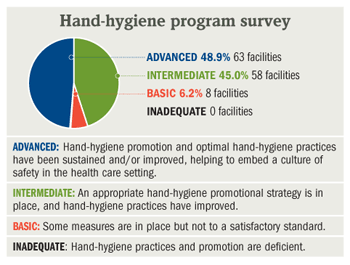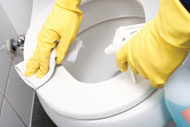 |
|---|
| Source: American Journal of Infection Control This pie chart shows the level of progress in hand-hygiene implementation in U.S. health care facilities participating in the WHO hand-hygiene self-assessment survey. |
A study that examined compliance by U.S. health care facilities with World Health Organization (WHO) hand-hygiene guidelines shows that nearly all have an advanced- or intermediate-level program in place.
Of the 129 health care facility respondents, 91 facilities, or 94 percent, reported having an advanced- or intermediate-level hand-hygiene program. Only eight health care facilities, or 6 percent of respondents, reported having just a basic program, and none reported having an inadequate program, the study shows.
The study was conducted by the Columbia University School of Nursing and WHO and was published in the American Journal of Infection Control.
The respondents answered a hand-hygiene self-assessment tool to evaluate their level of implementing a multimodal hand-hygiene strategy that WHO released in 2009.
Participants were mostly acute care hospitals and ambulatory care facilities followed by some long-term care facilities.
The self-assessment tool asked respondents to grade themselves in five areas, including system change, training and education, evaluation and feedback, workplace reminders and institutional safety climate for hand hygiene. Scores placed each facility at one of four levels ranging from advanced to inadequate.
Elaine Larson, R.N., associate dean for research at Columbia University School of Nursing, and a contributor to the study, says there are several keys to facilities that achieved advanced- or intermediate-level hand-hygiene programs.
They include supportive leadership, effective feedback to staff, a shared responsibility among departments, friendly communication reminders and patient engagement, she says.
Staffing is important, too. The study shows that facilities with a higher ratio of infection preventionists per 100 beds had much higher self-assessment scores than those with fewer specialists.
While 60 percent of respondents said they demonstrate a culture of institutional safety, the remainder did not, making it the weakest element of the program's strategies, Larson says.
"We really need to work on integrating things like hand hygiene into the broader culture. People tend to think of things in silos. Sometimes staff consider hand hygiene to be the problem of infection control rather than an integral part of what they do," Larson says.





